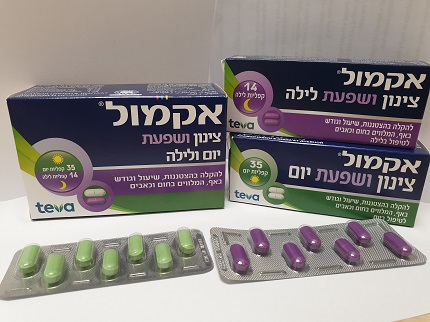Quest for the right Drug

אקמול צינון ושפעת לילה ACAMOL TSINUN & SHAPA'AT NIGHT (CHLORPHENIRAMINE MALEATE, DEXTROMETHORPHAN HYDROBROMIDE, PARACETAMOL, PSEUDOEPHEDRINE HYDROCHLORIDE)
תרופה במרשם
תרופה בסל
נרקוטיקה
ציטוטוקסיקה
צורת מתן:
פומי : PER OS
צורת מינון:
קפליות : CAPLETS
עלון לרופא
מינוניםPosology התוויות
Indications תופעות לוואי
Adverse reactions התוויות נגד
Contraindications אינטראקציות
Interactions מינון יתר
Overdose הריון/הנקה
Pregnancy & Lactation אוכלוסיות מיוחדות
Special populations תכונות פרמקולוגיות
Pharmacological properties מידע רוקחי
Pharmaceutical particulars אזהרת שימוש
Special Warning עלון לרופא
Physicians Leaflet
Adverse reactions : תופעות לוואי
4.8 Undesirable effects Adverse drug reactions identified during clinical trials and post-marketing experience with paracetamol, pseudoephedrine, dextromethorphan, chlorpheniramine or the combination are listed below by System Organ Class (SOC). The frequencies are defined according to the following convention: Very common ≥1/10 Common ≥1/100 and < 1/10 Uncommon ≥1/1,000 and <1/100 Rare ≥1/10,000 and <1/1,000 Very rare <1/10,000, including isolated reports Not known (cannot be estimated from the available data) ADRs are presented by frequency category based on 1) incidence in adequately designed clinical trials or epidemiology studies, if available, or 2) when incidence cannot be estimated, frequency category is listed as 'Not known'. System Organ Class (SOC) Frequency Adverse Drug Reaction (Preferred Term) Blood and lymphatic system Not known Blood disorders, blood dyscrasias (including agranulocytosis disorders and thrombocytopenia) have been reported following paracetamol use but were not necessarily causally related to the drug haemolytic anaemia, blood dyscrasias Immune system disorders Rare Hypersensitivity (cross-sensitivity may occur with other sympathomimetics) Unknown: allergic reaction, angioedema, anaphylactic reactions Psychiatric disorders Common Insomnia Nervousness Not known Anxiety Euphoric mood Excitability Hallucinations Irritability Paranoid delusions Restlessness Sleep disorder Drug dependence (see section 4.4) confusion*, excitation*, irritability*, nightmares*, depression Nervous system disorders Headache Very common sedation, somnolence Dizziness Common disturbance in attention, abnormal coordination, headache Not known Cerebrovascular accident Paraesthesia Posterior reversible encephalopathy syndrome (PRES)(see section 4.4)/Reversible cerebral vasoconstriction syndrome (RCVS)(see section 4.4) Psychomotor hyperactivity Somnolence Tremor rare Dizziness, drowsiness, mental confusion Common: blurred vision Eye Disorders Not known Ischaemic optic neuropathy Ear and labyrinth disorders Unknown: tinnitus Cardiac disorders Not known Dysrhythmias Myocardial infarction/myocardial ischaemia Palpitations Tachycardia arrhythmias Hypertension Vascular disorders Not known Hypotension Gastrointestinal disorders Common Dry mouth Nausea Not known Abdominal pain Diarrhoea Ischaemic colitis Vomiting dyspepsia rare Gastrointestinal upset Rare Hepatic necrosis Hepatobiliary disorders Unknown: hepatitis, jaundice Skin and subcutaneous tissue Rare Rash disorders Not known Angioedema Fixed eruption Pruritus Rash pruritic Severe skin reactions, including Acute generalised exanthematous pustulosis (AGEP) Urticaria exfoliative dermatitis, rash, photosensitivity General disorders and Common: fatigue administration site conditions unknown drug withdrawal syndrome chest tightness Metabolism and nutritional Unknown: anorexia disorders Respiratory, thoracic and Unknown: thickening of bronchial secretions mediastinal disorders: Musculoskeletal and Unknown: muscle twitching, muscle weakness connective tissue disorders Renal and urinary disorders Uncommon Nephropathy toxic Not known Dysuria Renal papillary necrosis (after prolonged administration) Urinary retention (in men whom prostatic enlargement could have been an important predisposing factor) *Children and the elderly are more likely to experience the neurological anticholinergic effects and paradoxical excitation(e.g. increased energy, restlessness, nervousness). Chronic hepatic necrosis has been reported in a patient who took daily therapeutic dosages of paracetamol for about a year and liver damage has been reported after daily ingestion of excessive amounts for shorter periods. A review of a group of patients with chronic active hepatitis failed to reveal differences in the abnormalities of liver function in those who were long-term users of paracetamol nor was the control of their disease improved after paracetamol withdrawal. Very rare cases of serious skin reactions have been reported with paracetamol. Reporting of suspected adverse reactions Reporting suspected adverse reactions after authorisation of the medicinal product is important. It allows continued monitoring of the benefit/risk balance of the medicinal product. Any suspected adverse events should be reported to the Ministry of Health according to the National Regulation by using an online form https://sideeffects.health.gov.il/

שימוש לפי פנקס קופ''ח כללית 1994
לא צוין
תאריך הכללה מקורי בסל
לא צוין
הגבלות
לא צוין
מידע נוסף
עלון מידע לצרכן
21.06.15 - עלון לצרכן אנגלית 21.06.15 - עלון לצרכן עברית 21.06.15 - עלון לצרכן ערבית 11.10.22 - עלון לצרכן 11.10.22 - עלון לצרכן עברית 12.12.22 - עלון לצרכן אנגלית 12.12.22 - עלון לצרכן עברית 12.12.22 - עלון לצרכן ערבית 26.09.23 - עלון לצרכן 06.12.23 - עלון לצרכן אנגלית 06.12.23 - עלון לצרכן עברית 06.12.23 - עלון לצרכן ערבית 20.03.24 - עלון לצרכן עברית 17.07.24 - עלון לצרכן אנגלית 17.07.24 - עלון לצרכן עברית 17.07.24 - עלון לצרכן ערבית 01.08.24 - עלון לצרכן עברית 17.08.14 - החמרה לעלון 07.09.22 - החמרה לעלון 26.09.23 - החמרה לעלון 21.03.24 - החמרה לעלון 01.08.24 - החמרה לעלוןלתרופה במאגר משרד הבריאות
אקמול צינון ושפעת לילה